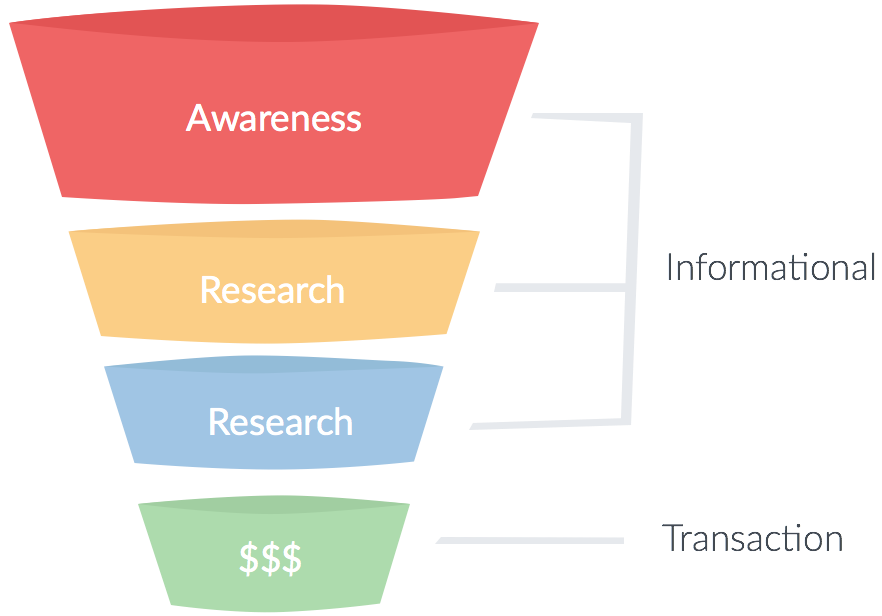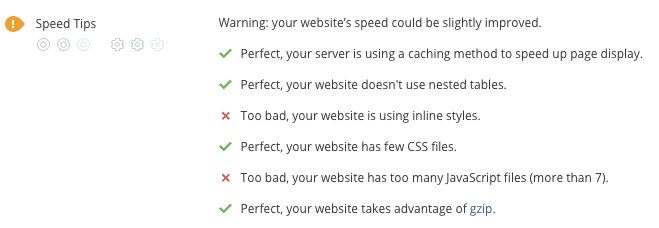
This article is part of an SEO series from WooRank. Thank you for supporting the partners who make SitePoint possible.
So you’ve decided to start an SEO campaign for your website. Congrats! Unfortunately, you don’t know where to start. Or maybe you know where to start, but don’t know how to continue.
With Facebook, retargeting, AdWords and other PPC channels, setting up a campaign is pretty easy to understand. You build landing pages, create ad creative and then bid on your keywords/impressions. However, with SEO, maybe it isn’t quite as straightforward.
The good news is that it’s actually not too complicated, even for digital marketing novices and newbies. The even better news is that we’re about to tell you how to plan and execute an SEO campaign for your website.
1. Define Your Goals and Strategy
As the saying goes (and as college me learned first-hand), if you fail to plan, you plan to fail. The same goes for your SEO campaigns. The first major thing you need to decide is how you’re going to define success and how you’ll measure progress toward those goals.
When it comes to SEO, your first thought might be “This is obvious. I want the top ranking in Google. That’s what SEO is all about!â€
Unfortunately, you need to dig deeper than just ranking in Google, or even website vanity metrics like traffic, bounce rate and engagement. What you really need to do is ask yourself three questions:
- Who am I trying to reach by ranking at the top of Google? Answering this question will define your target audience and create your marketing personas. Just saying “digital marketers†isn’t going to be very helpful because that’s a very diverse group of people. Here at WooRank, we’ve got at least six different personas with their goals, challenges, wants and needs along with what messaging we will use to reach them.
- Why am I trying to bring these people onto my website? What is the overall goal you are trying to achieve with this campaign? Again, don’t get sucked into focusing solely on vanity metrics like website traffic or engagement rates. Instead, decide what business goal you’re trying to achieve. Lead generation? Sales? List building? Be specific and concrete.
- How will I measure progress/achievement related to my goals? These are hard numbers used to calculate how successful your efforts are. Common metrics here are conversion rate, or email and retargeting list membership. If you can’t come up with a metric here to measure goal progress, you probably need to pick a better-defined goal.
You might be tempted to skip this first step and move right to the nuts and bolts of an SEO campaign, but the importance of this part can’t be overstated. It will be really, really hard for you to succeed if you don’t even know what success will look like. If you need more help coming up with your SEO, we’ve got a handy guide for you.
2. Keyword Research
Keywords are still really important parts of search marketing and SEO. However, the way you go about researching and optimizing around them has changed. You can thank Google’s Hummingbird and RankBrain for that. These two algorithms are focused on interpreting the context of words used in a search query and what the purpose behind a query is. It’s how Google figures out if your search involving “apple†is about computers, records or a fruit.
In SEO, this context is known as search intent. There are three main categories of search intent:
- To learn more about a topic: As you probably guessed, these people want to find more information on a topic, the answer to a question or the solution to/cause of a problem. Long tail informational keywords usually include words like “how toâ€, “do I need†or “what isâ€. Head keywords are typically informational keywords.
- To evaluate their options: These people already know something about the topic those first searchers were looking for and are now weighing their options. They’re deciding which product or solution is right for them. These keywords typically use phrases like “reviewâ€, “top 10â€, “best†or “comparisonâ€. They also use words like “cheap†and “dealsâ€, which are great indicators that they’re about to flip from this category to the next.
- To complete an action: Whether it’s making a purchase, signing up for a service or creating an account, these people know what they want and are ready to make it happen. They expect to achieve their goal directly on the landing page. They typically have lower volume but higher conversion rates.
The great thing about this development in keyword research is that search intent helps inform you where the searcher is in the conversion funnel.

If you’re struggling to come up with good keyword ideas in any phase of the funnel, there are lots of great tools out there that will help you find the right keywords. Here are some of my favorites:
Check out the keyword research guide for an in-depth look at the keyword research process.
3. Audit, Audit, Audit
Ok, you’ve come up with your personas and goals, and done your keyword research to find the best ones for your audience and funnel. The foundation of your SEO campaign has been laid. So now it’s time to build. That first building block? SEO audits.
Technical Audit
Technical SEO is the process of building a website in a way that makes it crawlable to search engines. If it’s not right, a website could struggle, or even fail, to get indexed. That means no search results for you!
When starting your SEO campaign, you need to get off on the right step by making sure your site is setup correctly. When auditing your website, check the following technical SEO elements:
-
XML sitemap: Search engines use a website’s sitemap to find and prioritize your URLs, an important SEO function (even if it’s not a ranking factor).
-
Robots.txt: Like sitemaps, robots.txt isn’t a ranking factor, but it will help you influence how your site is crawled. Prevent unimportant, duplicate or otherwise less valuable pages from being indexed so search engines can spend more of their crawl budget on what matters. Plus, you can put a link to your sitemap here to make that easier to find.
-
Page speed: Load time is a crucial part of user experience and, therefore, SEO. No search engine wants to recommend a slow site. There’s a lot of reasons your site could be slow. With WooRank’s technical SEO audit, we’ll alert you to slow page speed and possible causes.

-
URL structure: Make sure you’re following URL best practices for SEO. Make them concise and accurate to the page content, and avoid using underscores to separate words. Use hyphens instead. If you use parameters in your URLs, use Google’s URL Parameters Tool in Google Search Console to help Google deal with potential duplicate content issues.
-
Meta tags: Page titles and descriptions are super important to your on-page optimization. Even though only titles work as a ranking factor, descriptions can still convince users to click on your link in search results and keep them engaged on your site. These are two very important parts of maintaining relevance to your target keywords.
Crawl Your Site
For bigger, more complicated sites that have lots of pages, it’s worth it to use a crawler to audit your website. Crawlers work by accessing every URL on a website and collecting information about those URLs. Which is how Google’s crawlers work.
With an SEO crawler such as WooRank’s Site Crawl tool, you can analyze the URLs on your website and receive an analysis of the issues that will impact how Google indexes your site. Use the crawler to uncover issues with:
- On-page SEO: Issues with HTML can cause Google to see duplicate and/or empty pages. Having a large number of these pages on your domain will impact your whole site’s ability to rank.
- HTTP status: Search engines can’t crawl pages that can’t load or sites on servers that don’t respond. These pages also disrupt your site’s flow of link juice and provide a bad user experience. This step should also uncover any issues you have with broken redirects, redirect chains or redirect loops. These are all bad for SEO.
- Non-indexable pages: Having a properly written robots.txt file is just as important as having the file at all. Crawling your website will find URLs that are disallowed via robots.txt and meta robots tags. Incorrect, outdated or inadvertent meta robots tags are one of the leading causes of unindexable pages.
- Canonical issues: Canonical URLs are your “main†URLs. They’re the ones you want humans to access and where you want things like link juice and authority to collect. However, if you mess up your canonical tags, or the URLs in your tags don’t match your sitemap, you can run into problems.
Once you’ve fixed the potholes you’ve found in your website’s technical infrastructure, you can move on to some of the more “traditional†SEO stuff in your campaign.
4. Create Content
In the next step of your SEO campaign, it’s time to put to use all that work you did creating your strategy and researching keywords. That means it’s time to create some content.
When creating your content, think about the user first. Who is the target audience for this piece of content and what stage are they in the conversion funnel? Those two factors will help you decide which keyword you uncovered in your keyword research to optimize around.
When optimizing your on-page content for SEO, focus on:
- Keyword consistency: Thanks to advances in how Google reads content, the days of keyword density are over. Instead, make sure you’re using your keywords (and related words) throughout the page, and at every level. That means the body copy, but also the headers and subheads.
- Value: Everyone’s talking about producing quality content as an SEO tactic. I’m sure many of you hear “killer content†and “content is king†in your sleep by now. How can you measure “content� By focusing on the value you’re offering the user. This ties back to the intent of your keyword. Make sure your content solves the problem, explains the information or answers the question of the user.
- Links: We’re not talking about backlinks here, we mean your internal and outbound links. Internal links are a great way to distribute link juice around your site by adding them to high-authority pages. And while it’s not certain, there has been some evidence that linking out to quality resources can also help your SEO. So take advantage of this by linking out to high authority websites when appropriate.
- Images: Images are vital to user experience (no one likes huge blocks of text). But you can also use them as part of your SEO campaign. This is done by the HTML alt parameter in the image tag. Google uses the alt tag to “see†the image, so describe what’s going on in it. Only use relevant images and you’ll have another place to use your keyword. Alt text is also an important part of usability for people using screen readers or with slow internet connections.
5. Build Links
Just like you’ve probably heard all about content quality, you’ve probably heard about “link earning†replacing “link building.†Do not believe this. Most content doesn’t receive any shares or links without some sort of promotion, so just trusting in your great writing isn’t enough.
The key to successful link building is to, yet again, go back to your marketing personas and SEO strategy. If your content is useful for them, people catering to the same audience will be much more likely to link to it.
Use a link building platform such as BlogDash, or curate a list of influencers in your niche and collect as much information about them as you can. Then, start your outreach.
You can automate your blogger outreach if you want, but you won’t succeed. People can sense a form email a mile away, and you’ll likely get caught in spam filters anyways. Instead, send emails manually, using a basic outline or template to guide you. Focus on optimizing:
- Value: If you aren’t saying something new, or providing a unique outlook on an existing issue, people probably won’t want to link to your content. Start off your email with a brief (one or two sentences) outline of what value your content will bring readers. Show that you know their audience.
- Links: Don’t paste URLs directly into your email. It makes it look like a form letter. Instead, use hyperlinks in the text of the email. You’ll look less spammy that way.
- Subject line: Everyone gets a ton of emails, and for bloggers, a large percentage of them will be for link building. What I’m saying here is that it’s hard to stand out. Make sure your subject line is attention-grabbing and specific enough that the recipient knows what you’re talking about, but vague enough they’ll be compelled to open the email.
- Contact info: Sign off with real, accurate contact information. That means your individual contact info, not just business website and email address. Include name, your email, website, social media and even phone number to prove that you’re legitimate.
Don’t get too discouraged by low conversion rates. This step in your SEO campaign is as much about building a relationship for future links as it is about any one particular link. Plus, you should be targeting the big names in your niche, so even a few links should go a long way.
6. ABC – Always Be Checking
Alright, so you’ve set up the foundation of your campaign with a great strategy to reach your personas, you’ve got a great group of keywords on your topic, you’ve fixed the technical issues on your site, created some fantastic articles and built some links. Great job! But you’re not done yet.
First of all, there’s no guarantee that anything you’ve done so far has really worked. You need to be constantly checking to make sure any changes have a positive impact. Track your bounce rates to make sure your personas, keywords and funnel strategy are matching. Watch your rankings and website traffic to see how well your pages are optimized. Keep an eye on crawl errors and indexed pages to make sure the technical aspect of your site isn’t broken somewhere. And measure your link building efforts and tweak your subject lines, email body and recipient lists accordingly.
SEO, like most digital marketing channels, is a continuous process of testing, optimizing and testing again. Which is why you need to set up your campaigns correctly based on solid strategy, keyword research, website construction and content. If you combine these six steps correctly, you’ll see positive returns on your SEO campaign.
Article source: https://www.sitepoint.com/how-to-run-an-seo-campaign-in-6-steps/
